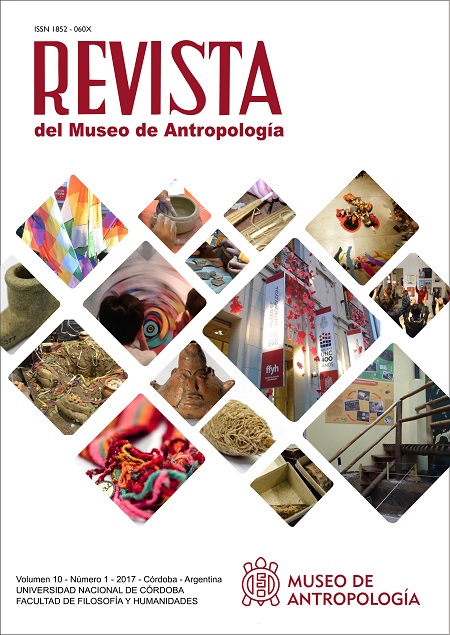New data on hunter gatherer coastal use at the southern tip of the continent during the late Holocene. Cabo Vírgenes 24 site (Santa Cruz, Argentina)
DOI:
https://doi.org/10.31048/1852.4826.v10.n1.14747Keywords:
Late Holocene, coastal Patagonia, inland hunter-gatherer, expedient technology, marine and terrestrial resources exploitationAbstract
Cabo Vírgenes 24 (CV24) is an archaeological site located at the Southeastern end of continental Patagonia and shows occupations between 753 to 888 (1270 ± 60 14C B.P; LP3229) and 545 to 626 Cal B.P (619 ± 26 14C B.P; AA106800). Lithic artifacts were mainly made on locally available raw material (dacite and RGFO). The identified technological expedient component is in accordance with inland guanaco hunters. The faunal record shows low density and moderate richness of marine and terrestrial faunal species. There is an emphasis on exploitation of pinnipeds (Arctocephalus australis and Otaria flavescens), followed by guanaco (Lama guanicoe) and, to a lesser extent, seabirds (Phalacrocorax sp., Spheniscus magellanicus and Aptenodytes patagonicus). The archaeological record of CV24 reaffirms the observed trends related to the sporadic and marginal use of the Cabo Vírgenes locality by hunter-gatherer populations since the Late Holocene until the European contact.Downloads
References
Barberena, R., y L. A. Borrero. 2010. Geoarqueología y distribuciones subsuperficiales de materiales arqueológicos: localidad de Cabo Vírgenes. Editores L. A. Borrero y J. Charlin, Arqueología de Pali Aike y Cabo Vírgenes, Cap. 5 pp: 103-122, CONICET-IMHICIHU, Buenos Aires.
Belardi, J., F. Carballo Marina y G. L. L’Heureux. 2011. Nuevos resultados arqueológicos en Cabo Vírgenes (Santa Cruz, Argentina): el sitio Cabo Vírgenes 20. Magallania 39(2): 279-292.
Behrensmeyer, A. K. 1978. Taphonomic and ecologic information from bone weathering. Paleobiology 4(2): 150-162.
Borrero, L. A., N. V. Franco, R. Barberena, F. Borella, P. Campan, F. Carballo Marina, I. Cruz, C. Favier Dubois, R. A. Guichón, G. L. L’Heureux, M. V. Mancini, L. Manzi, y F. M. Martin. 2008. Arqueología en Cabo Vírgenes y cañadón Gap. Editores I. Cruz y M. S. Caracotche, Arqueología de la costa patagónica. Perspectivas para la conservación, Cap. 13, pp: 212-228. Universidad Nacional de la Patagonia Austral, Río Gallegos.
Charlin, J. 2005. Aprovisionamiento de materias primas líticas en el campo volcánico de Pali Aike (Santa Cruz): una primera aproximación a partir del análisis de los núcleos. Werken 7(2): 39-55.
González Bonorino, G. 2002. Erosión y acreción litoral durante el Holoceno, en especial referencia a las puntas Bustamante y Dungeness. Editor M. J. Haller, Geología y Recursos Naturales de Santa Cruz, 20: 317-324. XV Congreso Geológico Argentino, El Calafate.
L’Heureux, G. L, J. Belardi y F. Carballo Marina 2012. Exploitation of fauna at Cabo Vírgenes, Patagonia Argentina, during the late Holocene. Editor Christine Lefebre, Proceedings of the General Session of the 11th International Council for Archaeozoology Conference, pp. 237-244. BAR 2354, Archaeopress, Oxford.
Massone, M. 1984. Los paraderos tehuelches y prototehuelches en la costa del estrecho de Magallanes. Anales del Instituto de la Patagonia. Serie Ciencias Sociales 15: 27-43
Downloads
Published
Issue
Section
License
Those authors who have publications with this Journalaccept the following terms:
a. Authors will retain their copyrights and guarantee the journal the right of first publication of their work, which will be simultaneously subject to the Creative Commons Attribution License (Licencia de reconocimiento de Creative Commons) that allows third parties to share the work as long as its author and his first publication in this journal.
b. Authors may adopt other non-exclusive licensing agreements for the distribution of the version of the published work (eg, deposit it in an institutional electronic file or publish it in a monographic volume) provided that the initial publication in this journal is indicated.
c. Authors are allowed and recommended to disseminate their work on the Internet (eg in institutional telematic archives or on their website) before and during the submission process, which can lead to interesting exchanges and increase citations of the published work. (See The Effect of Open Access - El efecto del acceso abierto)












